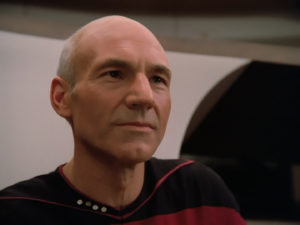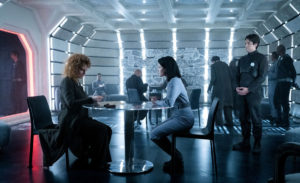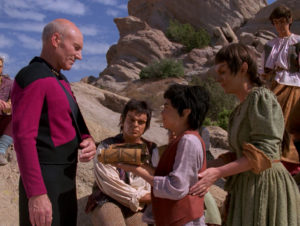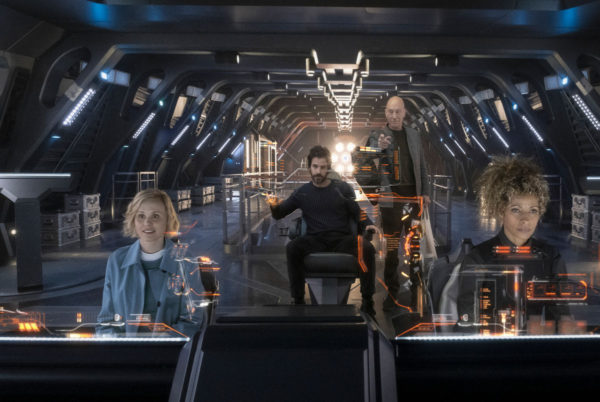There is ample evidence for the therapeutic utility of a shared mythical framework…
—Soji Asha
 It took three full episodes for us to get the first command to “Engage” from the former captain of the Enterprise, but it sure was worth the wait. We now have our season’s story fully established, our characters primed for the adventure, and our iconic captain back on the bridge of a starship, ready to boldly go. And with the swell of the orchestra, complete with a nod to the theme of The Next Generation, the legend of Jean-Luc Picard continues across the final frontier.
It took three full episodes for us to get the first command to “Engage” from the former captain of the Enterprise, but it sure was worth the wait. We now have our season’s story fully established, our characters primed for the adventure, and our iconic captain back on the bridge of a starship, ready to boldly go. And with the swell of the orchestra, complete with a nod to the theme of The Next Generation, the legend of Jean-Luc Picard continues across the final frontier.
I still remember grabbing a couch pillow and a blanket and curling up on the floor in front of the TV to watch the legend play out on the bridge of the Next Gen-era Enterprise-D. My parents and I would watch Picard and crew, and I’d go to school the next day and talk about their latest adventure with my friends. And you know what? Not much is different today, though the discussion is more often in front of my keyboard than my lunchbox. This is still a story I love to share.
The Shared Mythical Framework
In “The End is the Beginning” we find many characters searching to belong. We find Rios living (Han) solo aboard his ship, surrounded only by holograms of himself. Raffi, too, has drawn inward; explaining, “my entire life over the last 14 years has been one long slide into humiliation and rage.” Even Picard admits to Laris that he never felt like he belonged at Chateau Picard despite years of trying. Not to mention all the “nameless” ex-Borg and their virtuous advocate Hugh. The reaches of space feel a little colder for our characters, but hey, at least they’re together now.
 The evidence to support Soji Asha’s claim that a shared mythical framework may help restore the ex-Borg to their communities truly is ample. Star Trek itself is a shared mythology that brings us Trekkies together. Similarly, people from all sorts of backgrounds across the world communally share their love of narratives from Star Wars to Harry Potter to The Great British Baking Show. Stories bind us together because they echo our lives and teach us about who we are. I’m willing to bet even Soji has spent a few hours working through a good holonovel between her work with the ex-Borg.
The evidence to support Soji Asha’s claim that a shared mythical framework may help restore the ex-Borg to their communities truly is ample. Star Trek itself is a shared mythology that brings us Trekkies together. Similarly, people from all sorts of backgrounds across the world communally share their love of narratives from Star Wars to Harry Potter to The Great British Baking Show. Stories bind us together because they echo our lives and teach us about who we are. I’m willing to bet even Soji has spent a few hours working through a good holonovel between her work with the ex-Borg.
For the Christian, this goes beyond myth and a good conversation. The “framework” of the Christian worldview is Christ, and through His grace we learn to love others and act for their good. We love because Christ loved us, and through that love we are called to the Godly action of bringing about renewal in our communities. This is something the arc of Picard is currently mirroring (as David and I have both touched on in our recaps of episode one and episode two).
The News of the Gospel
“Religions vary in their degree of idiocy, but I reject them all. For most people, religion is nothing more than a substitute for a malfunctioning brain.”
—Gene Roddenberry
 Star Trek has had a weird relationship with religion. Roddenberry’s quote may seem damning, but ultimately the franchise has explored belief in a balanced way. For every religious zealot manipulating their way to power, there’s a Bajoran faithful praying to the prophets. In the season three Next Generation episode “Who Watches the Watchers,” Picard refers to a primitive culture’s abandonment of supernatural belief an “achievement,” calling their former belief “superstition, ignorance, and fear,” yet Picard so often embodies the grace of Christ when encountering new life and civilizations.
Star Trek has had a weird relationship with religion. Roddenberry’s quote may seem damning, but ultimately the franchise has explored belief in a balanced way. For every religious zealot manipulating their way to power, there’s a Bajoran faithful praying to the prophets. In the season three Next Generation episode “Who Watches the Watchers,” Picard refers to a primitive culture’s abandonment of supernatural belief an “achievement,” calling their former belief “superstition, ignorance, and fear,” yet Picard so often embodies the grace of Christ when encountering new life and civilizations.
In fact, it’s almost comical how often Star Trek’s stance on religion as merely superstition contradicts the actions of its characters, whose kindness and grace often echo that of our Creator. It’s a good distinction to see, honestly, because the gospel is not religion. It is truth. I love how Ramdha referred to Romulan “mythology” not as superstition, but as “news.” That’s how we see the gospel: not as myth, but as fact. And the good news of Christ is that we are free from the curse of the law. Christ brings about true restoration where the law only brings death.
That kind of restoration is the natural extension of what the Starfleet once stood for in its peaceful exploration. It’s what Picard fought for during the Romulan refugee crisis. And it’s what Soji is working towards with the ex-Borg, which is far more than a simple substitute for a malfunctioning brain. She may indeed be a destroyer, but if she’s a destroyer of division or injustice, then she may indeed be the symbol of unity Picard is seeking in his mission.
If anyone can find her and bring some restoration to a lost people, I’d put my latinum on the man who once worked alongside Spock in an attempt to unify the Vulcans and Romulans. You know, the chief contact with the Q Continuum, the Arbiter of Succession for the Klingon Empire, the Savior of Earth from the Borg invasion? Yeah, that guy. He has so many stories we could discuss. So, no matter where he goes from his Chateau in the coming weeks, it will no doubt produce more good ones to share.

